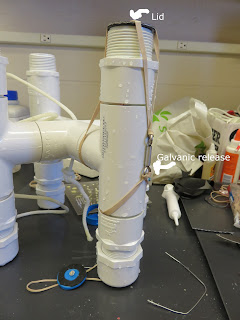Construction day: Part 3
 |
| Not exactly candy: my PVC lids super glued to neoprene |
Step two. The PVC alone won't be enough to seal the traps, so I needed something a bit more waterproof. I super glued neoprene to the PVC discs - actually, more accurately, I super glued the PVC discs to a sheet of neoprene, remarked to myself that they looked like candy buttons on paper, and cut them out. I drilled holes through the center of the discs, then threaded rubber bands through the holes. The rubber bands will hold the lids in place so my traps are sealed while they're being deployed, then pull the lids off after about a day. I want the lids to open once the samplers have settled into their places so they can start catching larvae.
 |
| Larval trap lid and galvanic release setup |
The design I'm using is modified from one my Ph.D. advisor came up with. Essentially, the trap lids are held on by tightly-stretched rubber bands, and when the galvanic release corrodes through, the rubber bands are no longer connected and the lid flies off. I actually tested the lid setup off of the dock near my lab to make sure the lids would open but stay connected to the trap housings, and it worked.
Friends, I am tired, but it's nice to see my construction projects coming together. Slowly but surely, everything will get built!
Comments
Post a Comment